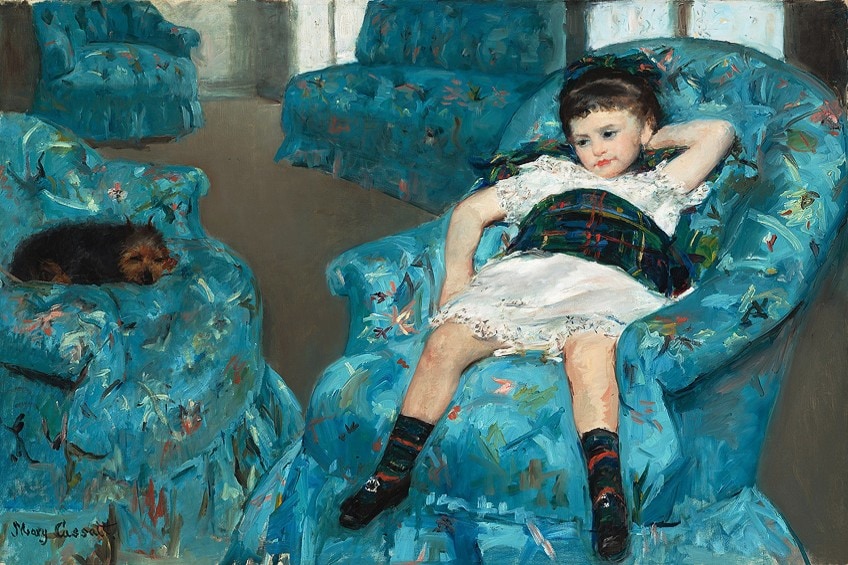Famous Impressionist Painters – Discover Impressionist Artists
Impressionist artists were not interested in creating artworks that depicted history or mythology. Instead, famous Impressionist painters sought to depict what they felt and experienced from a scene, rather than how realistically it was portrayed. This meant that impression painters often employed loose brushwork to capture a scene, rather than detailed and complex brushstrokes. Today we will explore the famous Impressionists who made this style world-renowned, and one of the most important movements in art history.
The Most Famous Impressionist Painters
Believe it or not, the movement of the Impressionist artists was named after an insult to Claude Monet’s painting, Impression, Sunrise (1873). Louis Leroy, a French art critic, famously said of Monet and the other Impressionist painters that they produced nothing but impressions.
The Impression painters adopted the term, although they eventually identified as the “Independents.”
Even though the famous Impressionists’ techniques varied significantly, they were connected by a mutual concern for the expression of sensory perception, based on transitory optical experiences, and an emphasis on the transient moments of contemporary civilization.
Camille Pissarro (1830 – 1903)
| Nationality | French |
| Date of Birth | 10 July 1830 |
| Date of Death | 13 November 1903 |
| Place of Birth | US Virgin Islands |
Camille Pissarro met Danish artist Fritz Melbye in 1849, who supported him in his creative aspirations. Pissarro and Melbye departed St. Thomas for Venezuela in 1852, where they resided and spent several years working. Pissarro went back to Paris in 1855, where he attended the Académie Suisse and collaborated with artists Gustave Courbet and Camille Corot, improving his abilities and developing new methods of producing art.
Pissarro later became involved with a group of young painters, including Paul Cézanne and Claude Monet, who reflected his concerns and interests.

These painters’ work was rejected by the French artistic elite, which barred unconventional paintings from official Salon displays. Pissarro had a workshop in Paris, although he devoted much of his time to the city suburbs. He, like many of his colleagues, chose to paint images of rural life and the natural environment outside rather than in a studio. During this time, he also became engaged to Julie Valley, and finally married in 1871. Their new family life, unfortunately, was disrupted by the Franco-Prussian War of 1871, which caused them to evacuate to London.
When Pissarro returned to France at the end of the war, he realized that the bulk of his preexisting collection of works had been destroyed.

But Pissarro rapidly recovered from this setback. He quickly linked with his fellow artists, namely Monet, Edouard Manet, Cézanne, Pierre-Auguste Renoir, and Edgar Degas. Pissarro founded a collaboration of 15 painters in 1873 to provide alternatives to the Salon.
The group staged its debut show the following year.
The show’s unique topic and presentation astounded reviewers and helped to establish Impressionism as a movement. Pissarro, for his part, exhibited five works in the show. Over the next few years, the group would conduct numerous additional exhibits before gradually drifting apart.
Some notable artworks by Pissarro include:
- Paisaje tropical con casas rurales y palmeras (c. 1853)
- Jalais Hill, Pontoise (1867)
- The Crystal Palace (1871)
Édouard Manet (1832 – 1883)
| Nationality | French |
| Date of Birth | 23 January 1832 |
| Date of Death | 30 April 1883 |
| Place of Birth | Paris, France |
The art establishment was shocked by the works of Manet, who was an Impressionist painter. He left visible seemingly random brush strokes and eschewed the meticulous building up of texture utilizing subtle color transitions characteristic of professional painters.
Manet also surprised many by not depicting typical topics such as historical and mythical figures or scenic landscapes.
Manet’s depiction of common Parisian life, particularly its café culture, portraiture of regular people, and inventive still-life paintings were all in conflict with the ultra-conservative world of art and the Paris Salon, where such paintings were displayed and sold. Manet made more provocative statements about how he envisioned the universe. His Absinthe Drinker was a painting of a destitute figure, and it was unsurprising that it was denied by the Salon in 1859. Manet momentarily returned to a more traditional approach as a result of the controversy.

Manet’s picture of his parents, as well as The Spanish Singer, were both approved by the Salon in 1861, with the latter receiving praise. Lunch on the Grass by Manet in 1863 was a stunning return to his unconventional manner. Picnics were commonplace, but Manet made his startling by dressing the two people] in modern garb, one lady half-dressed, and the second nude.
This scenario might have been approved at the Salon des Refusés if it had been portrayed in a conventional manner, as a timeless allegorical or mythical theme.
For many reviewers, Manet’s present realism rendered the entire painting vulgar, as did his evident brushwork and garish colors. More controversy ensued when Manet’s work at the Salon show in 1865 was as disturbing as his picnic two years earlier. Olympia‘s acceptance was startling, but the Salon would soon come to lament its choice. Victorine Meurent, Manet’s long-time model, was seen resting on her bed and boldly staring directly at the observer.

Manet’s nakedness was astonishingly contemporary and unorthodox. The critics overlooked the other advances Manet was exhibiting, such as the unique colors, the way the two images appear to advance toward the observer, and the flat appearance of the composition, since they were more focused on the naked woman and her fearless glare.
Some notable artworks by Manet include:
- Olympia (1863)
- Le Déjeuner sur l’herbe (1863)
- The Railway (1874)
Edgar Degas (1834 – 1917)
| Nationality | French |
| Date of Birth | 19 July 1834 |
| Date of Death | 27 September 1917 |
| Place of Birth | Paris, France |
A gathering of young avant-garde painters congregated in Pari’s cafés and hotly debated the new path of art in the 1860s. Degas was a part of this collective, which was dubbed “the Batignolles.” He was occasionally alienated from the circle, more due to his own mentality rather than anything else, he often bumped heads with Manet, even if the two painters were artistically closest.
Manet objected to Degas’ inclusion of new talent and painters more concerned with reality than impressionism.
Degas was especially close to two notable female painters, Berthe Morisot and Mary Cassatt, both of whom he had personally introduced to the impressionist movement. In correspondence, Morisot characterized Degas as “always the exact same, a touch wild, but delightful in spirit.” Degas never wedded and kept his personal life secret, so the only glimpses we have are a few cautious comments from those few acquaintances who became close enough to the painter to be welcomed to his Montmartre workshops.
The Dance Class (c. 1873) by Edgar Degas, located in the National Gallery of Art in Washington D.C., United States; Edgar Degas, Public domain, via Wikimedia Commons
“The painter must live separate, his private life must remain a mystery,” Degas famously observed. With the commencement of the Franco-Prussian War in 1870, the group of Impressionist painters disbanded. Degas volunteered for the National Guard to protect France throughout the siege and Manet did the very same. Degas proceeded to produce portraits of his fellow French artillerymen. Then came a civil war, which proceeded to disrupt everyone’s careers.
It seemed like an opportune moment to get away from the upheaval, and in 1872, Degas sailed to New Orleans to see relatives.
There, in 1873, he produced a contemporary masterwork, The Cotton Market, New Orleans. Degas worked on a wide range of subjects, although some motifs recur throughout his work. He was particularly fond of horses and spent a lot of time examining them at the prestigious racetracks of Paris.
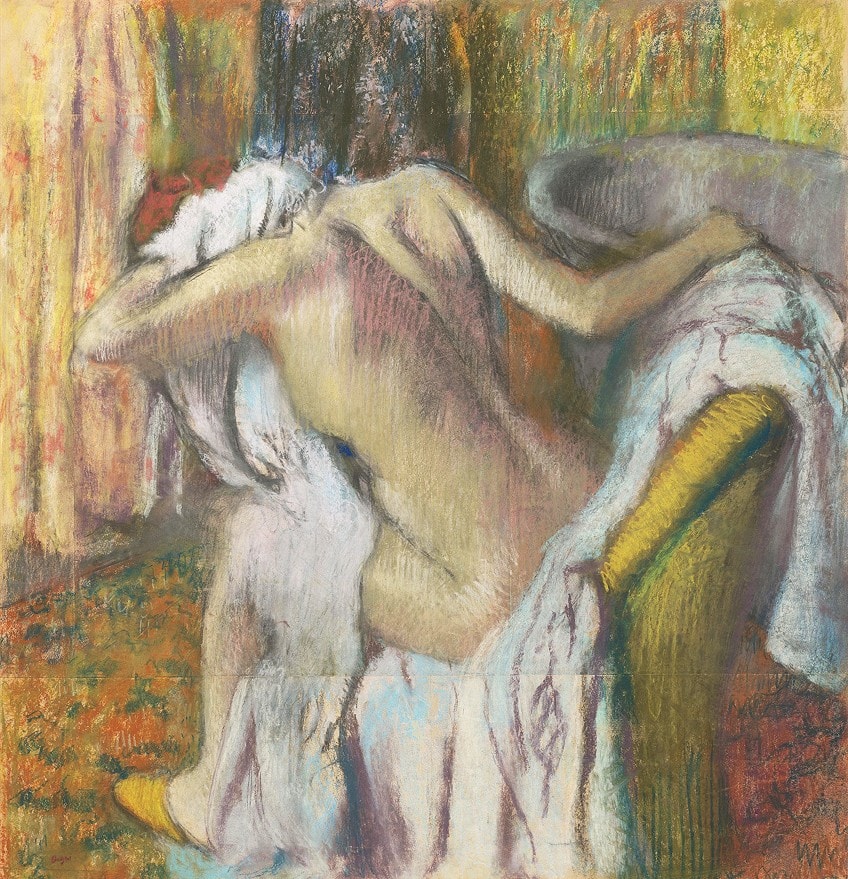
The circus’s color, the bustling café culture, and the seriousness of the stock market all drew his attention. The realm of theatre, notably operas and ballet, appears to have captivated the painter above all. Another recurring issue that piqued Degas’s attention was the behind-the-scenes aspect of social performance: he was fond of depicting animals between competitions and ballerinas during practice sessions.
Some notable artworks by Degas include:
- The Bellelli Family (1867)
- The Star (1878)
- After the Bath, Woman drying herself (1895)
Alfred Sisley (1839 – 1899)
| Nationality | British-French |
| Date of Birth | 30 October 1839 |
| Date of Death | 29 January 1899 |
| Place of Birth | Paris, France |
Alfred Sisley is probably one of the most underappreciated Impressionist artists. This might be because Sisley grew up between two nations, being born in France to British parents and later splitting his days between the two. As a result, despite being an important character in French Impressionism, he remained somewhat of an outcast.
Contrary to many of his contemporaries, who focused on city life and people, he was almost entirely a landscape painter, a topic from which he seldom deviated.
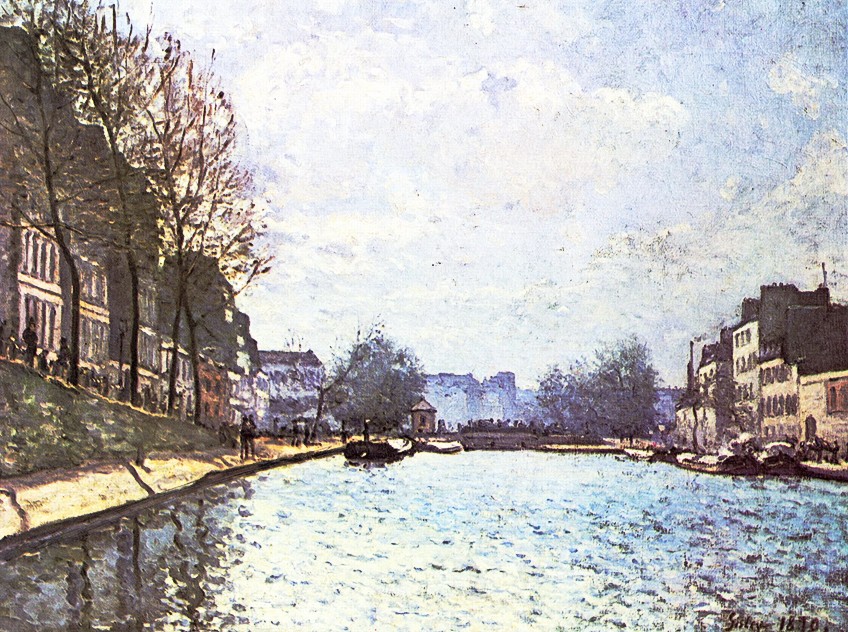
Furthermore, his works have a moodiness and specific colorism that show an impact from previous eras of British and French art, particularly the Barbizon school. As a result, Sisley developed his own distinct form of Impressionism, foreshadowing a number of the new painting forms that emerged in Europe at the beginning of the 20th century. Sisley’s landscapes are famous for their amazing ability to depict mood and light.
This impact is heightened by his large, emotive sky, which is virtually always a focal point of his works.
Despite being frequently seen as an outsider due to his English nationality, Sisley studied in Paris with Claude Monet and Pierre-Auguste Renoir, among others, and was a key character in the development of the new movement known as Impressionism. Although Sisley’s paintings are fairly attractive to the contemporary eye, it is crucial to understand that his work was extremely radical at the time.

His emphasis on contemporary, city life, his appreciation for nature as worthy subject material, and his sketchy, “impressionistic” manner were all trademarks of a new style of painting for an industrial world. Sisley’s attention to the intricacies of natural settings was astonishing, enabling him to produce landscapes that vibrate with the somewhat conflicting ideas of physical reality and dreamlike sentimentality at the same time.
Some notable artworks by Sisley include:
- View of the Canal Saint-Martin (1870)
- The bridge at villeneuve-la-garenne (1872)
- The Small Meadows in Spring (1881)
Paul Cézanne (1839 – 1906)
| Nationality | French |
| Date of Birth | 19 January 1839 |
| Date of Death | 22 October 1906 |
| Place of Birth | Aix-en-Provence, France |
Paul Cézanne, one of the most significant artists in contemporary painting history, has influenced numerous generations of painters. His distinctive style of constructing shapes with color and his methodological approach to nature impacted the work of the Fauves, Cubists, and subsequent groups of avant-garde painters. Cézanne began painting in 1860 in his hometown of Aix-en-Provence and later studied in Paris.
His early paintings of classical and romantic themes are suffused with dark hues and produced with emotive brushwork in the manner of Eugène Delacroix.
The intensity with which Cézanne worked throughout the 1860s is exemplified by striking tonal variations and dense layers of pigment, particularly in the portraiture set of artworks of his uncle Dominique Aubert. While Cézanne’s paintings at the inaugural Impressionist showcase in 1874 were not completely in keeping with the Impressionist methodology of quickly applying pigment to the painting, he did ultimately renounce his fairly dark palette in favor of more lively tones and started painting outside, urged by Camille Pissarro.

Bathers (1875) shows a matured technique and scale in one of his early works on this topic, which recurs throughout his oeuvre. The scenery in Bathers has the brightness of a Plein-air painting, but the characters are pulled from the artist’s mind (he seldom painted nudes from reality). Cézanne discarded his densely coated surface areas in his mid-1870s still-life works and started to tackle technical challenges of shape and color by playing with gently gradated tonal changes, or “productive brushstrokes,” to create depth in his subjects.
These works exhibit Cézanne’s renunciation of the dramatic extremes of light and shadow of his earlier years in favor of a sophisticated arrangement of color scales positioned close to one another.

The brightness of Impressionism can be seen in these pieces, yet traces of an updated palette can be seen in his subdued tones. His paintings from 1890 illustrate Cézanne’s artistic progress and mastery of this approach of producing settings with warped perspectival space. The items in these artworks are represented using extremely delicate color gradations rather than light or shadow.
Some notable artworks by Cézanne include:
- Mont Sainte-Victoire (1885 – 1906)
- Rideau, Cruchon et Compotier (1893)
- The Card Players (1894 – 1895)
Marie Bracquemond (1840 – 1916)
| Nationality | French |
| Date of Birth | 1 December 1840 |
| Date of Death | 17 January 1916 |
| Place of Birth | Landunvez, France |
While being named one of the three outstanding females of the Impressionist artistic movement by Henri Focillon, the acclaimed art historian in 1928, Marie Bracquemond’s beautiful paintings remained relatively unknown until around the 1980s.
Much of what we understand about her is based on a brief biography written by her only child, about his artistic mother and father, Felix and Marie.
In comparison, it was her husband, the clearly dominant Felix, who despised her career and despised the Impressionist manner, who played a crucial part in undermining Marie Bracquemond’s relevance in the Impressionist movement. Nonetheless, she continued honing her seeming tremendous skill, blending en Plein air painting methods from her adolescence into her professional practice while collaborating with some of the era’s most prominent painters, including Edgar Degas, Claude Monet, and, later, Paul Gauguin.
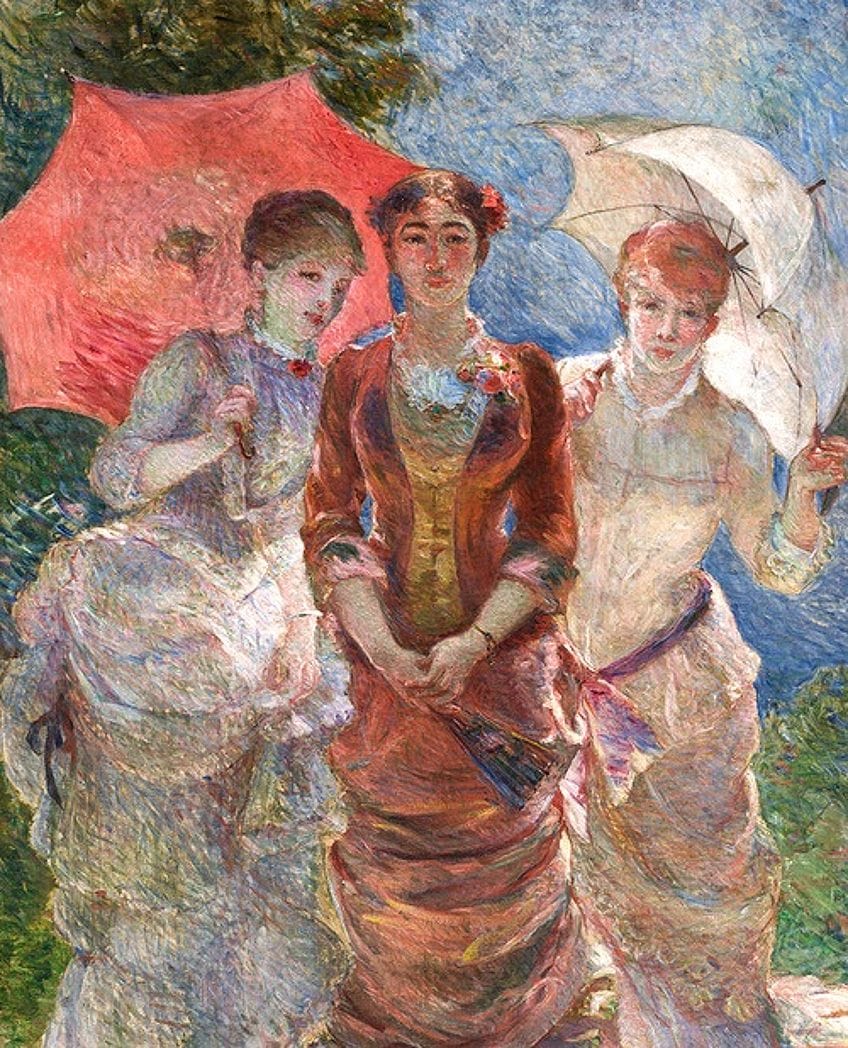
Bracquemond slowly developed her own distinctive, bright style, and she was honored with offers to display her work, particularly at Impressionist exhibits from 1879 through 1886. Bracquemond started her career as a refined academic artist, Realist style resembled the archaic works of Salon-approved artists like Regnault, Cabanel, and Gérôme rather than burgeoning avant-garde painters such as Degas and Monet.
Her manner started to evolve radically after meeting the two artists and she embraced the ideas of Impressionism, and by the 1880s her paintings could only be regarded as thoroughly Impressionist.
Bracquemond is noted for being a loner, especially as she grew older. While the majority of her Impressionist contemporaries liked painting en Plein air, many of her works were created in the garden of her house in the southwestern Parisian district of Sèvres.
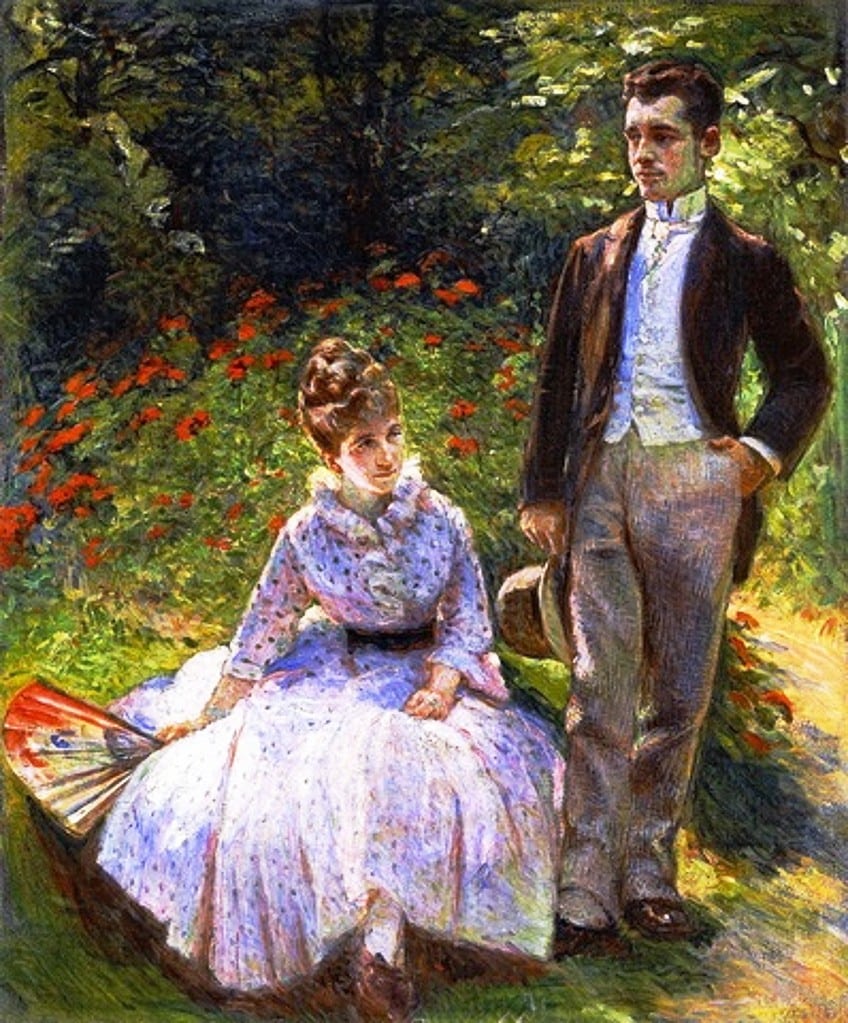
Her style began to shift around 1886, with her color palette becoming more vivid. This shift was largely owing to Bracquemond’s meeting with Gauguin in 1886. Felix, who had acquainted the then-poor, aspiring young painter, introduced the two. With Gauguin’s support, Bracquemond brightened her rather restrained Impressionist palette, which was paradoxical given that her husband objected most to her use of color, favoring printing in black and white to his wife’s favorite mode of oil painting.
Some notable artworks by Bracquemond include:
- Self-Portrait (1870)
- On the Terrace at Sèvres (1880)
- The Artist’s Son and Sister in the Garden at Sèvres (1890)
Claude Monet (1840 – 1926)
| Nationality | French |
| Date of Birth | 14 November 1840 |
| Date of Death | 5 December 1926 |
| Place of Birth | Paris, France |
Claude Monet was a pivotal contributor to the Impressionist art movement, which revolutionized French artwork in the second part of the 19th century. Monet captured the scenery and leisure pursuits of Paris and its outskirts, as well as the Normandy shore, during his long and successful career.
He cleared the path for 20th-century modernism by inventing a distinct style that sought to depict the experience of viewing life on canvas.
Eugène Boudin, noted for canvases of the villas that studded the region’s Channel shore, exposed Monet to Plein-air painting, and he later trained casually under the landscapist from the Netherlands, Johan Jongkind. Monet, then 22, joined the Paris workshop of classical history artist Charles Gleyre. Frédéric Bazille, Auguste Renoir, and other future famous Impressionists were among his students. Monet’s early success was modest, with only a few seascapes, landscapes, and portraits selected for presentation at the yearly Salons of the 1860s.

However, the rejections of several of his bolder paintings spurred Monet to form a separate gallery in 1874 with Édouard Manet, Edgar Degas, Renoir, Camille Pissarro, and others. One of Monet’s entries to this show, Impression, Sunrise (1873), garnered special contempt for the incomplete impression of its free handling and unclear outlines. The impression painters, however, embraced the critique as a medal of pride and later dubbed themselves “Impressionists” after the name of the artwork, even though the term was initially used contemptuously.
Monet selected subjects in his local surroundings, painting people and locations he was familiar with. Camille, his first wife, and Alice, his second wife, were both models.
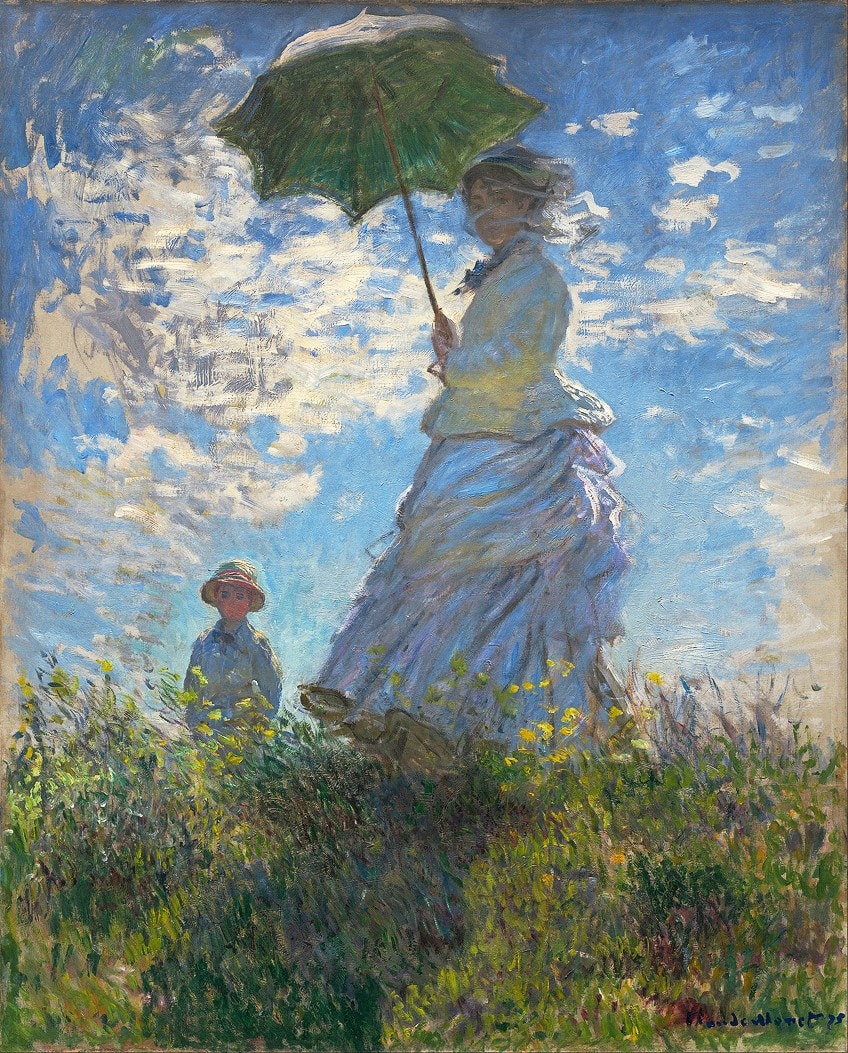
His landscapes depict excursions across northern France as well as to London, where he fled the Franco-Prussian War of 1871. Monet returned to France in 1883, first to Argenteuil, only 15 minutes by rail from Paris, then to Poissy, and eventually to the more rustic Giverny. His residences and gardens were gathering spots for friends such as Renoir and Manet, who frequently created alongside Monet.
Some notable artworks by Monet include:
- Sunrise (1872)
- Woman with a Parasol (1875)
- Water Lilies (1919)
Berthe Morisot (1841 – 1895)
| Nationality | French |
| Date of Birth | 14 January 1841 |
| Date of Death | 2 March 1895 |
| Place of Birth | Bourges, France |
Berthe Morisot, who was an Impressionist painter rose to prominence as a crucial player in the most famous creative movement of the 19th century despite her gender. Morisot developed her creative abilities and attained recognition at a young age, including admittance to the Salon at 23 years of age, and she determinedly maintained her position at the vanguard of French artists until her passing three decades later.
Despite being regularly critical of her own artwork and being refrained by social conventions from trying to pursue the same topics as her male equivalents, Morisot was capable of carving out her own career as a painter for more than 30 years.
Morisot ended up leaving a lasting impression on the direction of in France. Morisot was denied access to the entire spectrum of subject matter offered to her male counterparts, notably the nastier parts of city life – cafés, cabarets, taverns, and brothels – owing to her gender.

Her artworks, on the other hand, illustrate her accessibility to nearly every facet of feminine existence in the late 19th century, including private, personal ones that were typically restricted to her male colleagues. Morisot painted a broad range of subjects, encompassing landscapes, urban scenes, still lifes, nudes, and portraits.
Morisot, like her male peers, established preferred models, such as her own daughter, Julie, and engaged in the creative exchanges of the time as a result of her relationships inside the Impressionist group and well beyond, becoming a pioneer in art until her death.
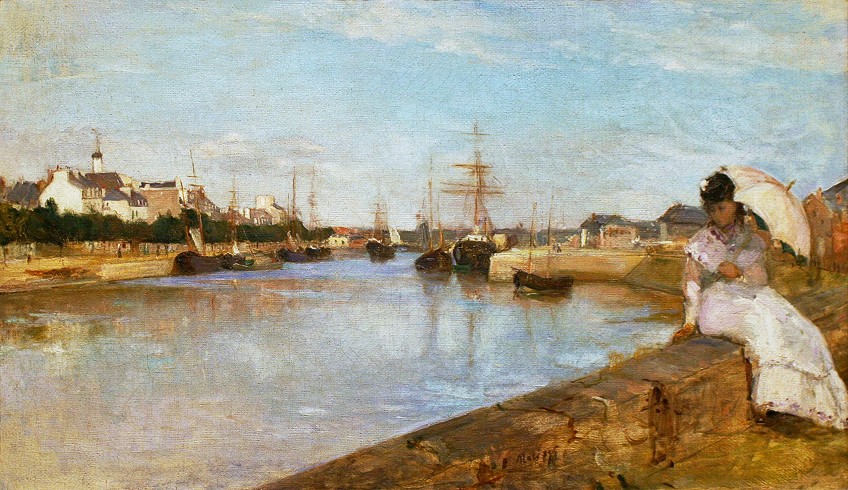
Morisot seemed to have the excellent fortune not only to be married into an artistic household but also to have her husband, Édouard Manet’s younger brother, Eugene, who renounced his own aspirations to supervise her creative career. She had a good sense of popular taste, and as a consequence, her works sold successfully throughout her lifetime and beyond. Her abilities and expertise earned her male colleagues’ public regard as an equal – a remarkable feat for the period.
Some notable artworks by Morisot include:
- The Harbour at Lorient (1869)
- View of Paris from the Trocadero (1871)
- The Cradle (1872)
Pierre-Auguste Renoir (1841 – 1919)
| Nationality | French |
| Date of Birth | 25 February 1841 |
| Date of Death | 3 December 1919 |
| Place of Birth | Limoges, France |
Pierre-Auguste Renoir returned to Paris when the war ended in 1871. In 1874, he and a group of colleagues notably Monet, Pissarro, Cézanne, and Degas, agreed to hold their own exhibit in Paris, which would become recognized as the inaugural Impressionist exhibition. Renoir, similarly to the other Impressionist artists, used a more vibrant palette in his works, giving them a brighter, warmer feeling. He also utilized multiple brushstroke types to convey his creative ideas on the canvas.
While the initial Impressionist exhibit was a failure, Renoir quickly found new benefactors who helped him further his career.
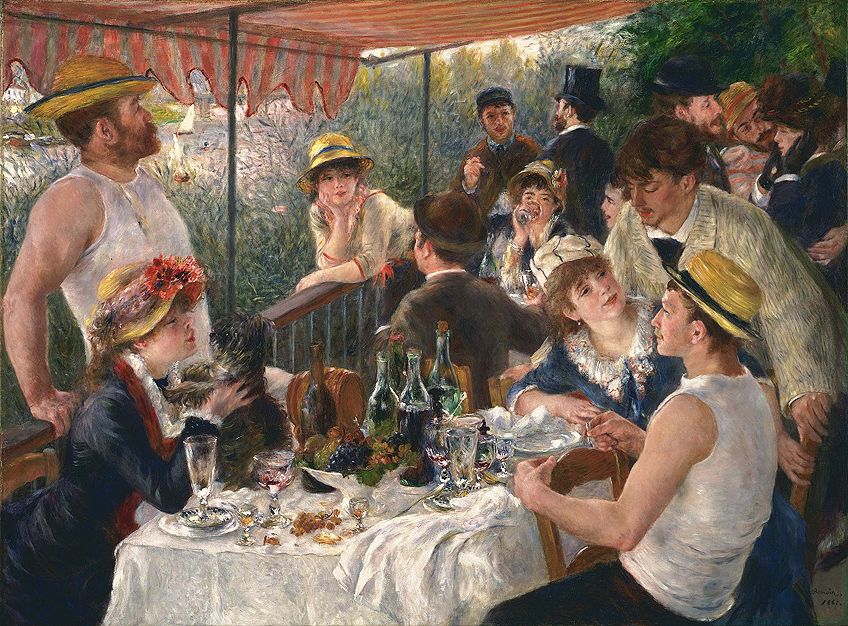
The artist piqued the eye of rich publisher Georges Charpentier, who invited him to several social occasions at his Paris house. Renoir met prominent writers such as Émile Zola and Gustave Flaubert through Charpentier. Portrait commissions were also offered to him by the couple’s friends. Renoir took many inspired excursions in the early 1880s, funded by commissions. He traveled to Italy, Algeria, and the south of France. Renoir produced a portrait of legendary composer Richard Wagner while in Naples.
Renoir started settling down as his career expanded.
In 1890, he became engaged to his longtime lover, Aline Charigot. Renoir’s distinctive airy brushstrokes were used to represent largely rural and household settings as he matured. His art, on the other hand, proved to be increasingly physically demanding for the painter. Renoir was diagnosed with rheumatism at some point in the mid-1890s and suffered from it for the remainder of his life.

Renoir purchased land in Cagnes-sur-Mer in 1907 and erected a magnificent mansion for his family. He kept painting and sketching whenever he could. His hands had been deformed by rheumatism, with his fingers chronically curled. Renoir also suffered a stroke in 1912, which forced him to use a wheelchair.
Some notable artworks by Renoir include:
- La Loge (1874)
- Luncheon of the Boating Party (1881)
- Dance at Bougival (1883)
Mary Cassatt (1844 – 1926)
| Nationality | American |
| Date of Birth | 22 May 1844 |
| Date of Death | 14 June 1926 |
| Place of Birth | Allegheny, Pennsylvania |
Mary Cassatt unwillingly went back home to stay with her parents in 1870, just after the commencement of the Franco-Prussian War. Her artistic independence while living overseas was quickly snuffed out when she returned to the suburbs of Philadelphia. Not only did she struggle to locate appropriate equipment, but her father declined to pay for anything related to her art. She attempted to sell some of her works in New York to obtain finances, but she was unsuccessful.
When she sought to market them again through a Chicago dealer, the works were unfortunately lost in a fire in 1871.
Cassatt was approached by the archbishop of Pittsburgh in the thick of these difficulties. He requested her to paint reproductions of two pieces by the Italian artist Correggio. Cassatt accepted the commission and promptly traveled to Europe, where the original versions were on exhibit in Parma, Italy. She was capable of resuming her work in Europe because of the commission revenue she received.
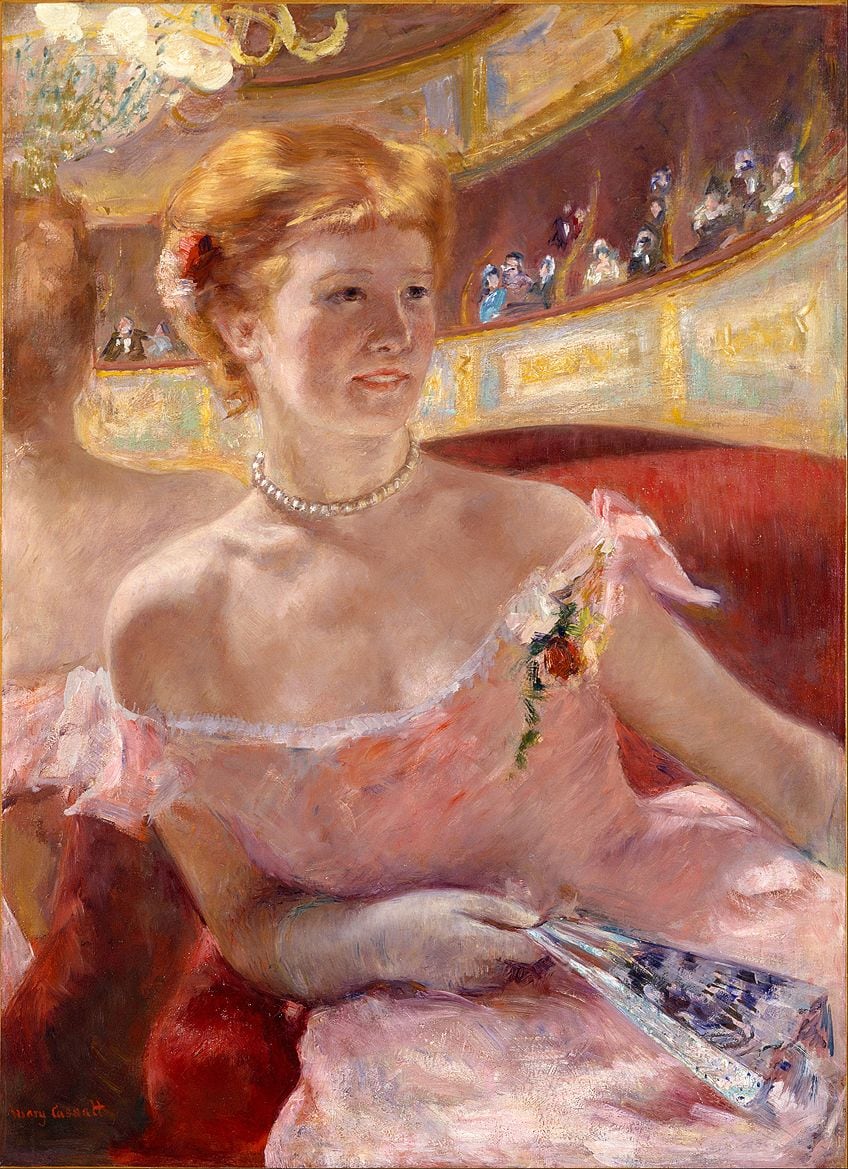
From 1872 until 1874, the Paris Salon approved her works for display, establishing her as an accomplished artist. She studied and painted in Belgium, Spain, and Rome before finally settling in Paris. Despite her gratitude to the Salon for helping her career, Cassatt came to feel more confined by its rigid restrictions. She started to explore creatively, no longer preoccupied with what was popular or marketable.
Her latest art was lambasted for its vivid colors and harsh depictions of its characters.

During this period, she found inspiration in the pastels of painter Edgar Degas, who encouraged her to pursue her own path. “I used to go and push my face against that glass and absorb as much of his work as I could,” she reportedly told a friend. “It transformed my life. I saw art because I wanted to.” Cassatt’s adoration for Degas grew into a deep relationship, and she displayed ten of her works alongside the Impressionists in 1879.
Some notable artworks by Cassatt include:
- Little Girl in a Blue Armchair (1878)
- Woman with a Pearl Necklace in a Loge (1879)
- The Cup of Tea (1880)
That concludes our look at 10 famous Impressionist painters. These notable Impressionist artists decided to shun the status quo in favor of a more expressive and loose style of art. The Impressionist painters then decided to boldly host their own exhibits, which ultimately rose to become a highly renowned art movement, despite initial negative critical reception from the established art world.
Frequently Asked Questions
What Is Impressionism?
In 1874, a group of painters organized an exhibit that was autonomous from the official Salon. Édouard Manet, the Avant-Garde’s head, was notably missing. Even though he never attended any of their shows, Manet’s flamboyant style and contemporary topics influenced these younger painters, who became known as the Impressionists. The moniker is traditionally credited to a scathing critic who pounced on the name of Claude Monet’s impressionistic sunrise painting. The reviewer, familiar with the more sophisticated pieces of the Salon, likened Monet’s indistinct harbor scene to wallpaper. He anticipated a picture rather than an impression. The term had already been widely used to describe quickly completed drawings and the aesthetic impression a location had on an artist at the time.
What Happened After Impressionism?
Because of Impressionism’s popularity, its younger adherents broke out in a variety of directions, spawning a slew of sometimes short-lived groups and schools. Nevertheless, there may have been a fundamental schism behind the emergence of post-Impressionism. On the one hand, some artists and schools emphasized the application of color and brushstrokes to reflect the artist’s emotional and mental life rather than the pure visual impressions delivered by innovators such as Monet. On the other side, some attempted to define and perfect the optical methods that underpinned the early Impressionist style.
Who Was an Impressionist Painter?
During the second half of the 19th century, there were many influential Impressionists emerged, especially in France. Characters such as Claude Monet, Pierre-Auguste Renoir, and Paul Cézanne helped define the style. Several important famous Impressionist painters were women, such as Mary Cassatt, Berthe Morisot, and Marie Bracquemond.
Jordan Anthony is a Cape Town-based film photographer, curator, and arts writer. She holds a Bachelor of Art in Fine Arts from the University of the Witwatersrand, Johannesburg, where she explored themes like healing, identity, dreams, and intuitive creation in her Contemporary art practice. Jordan has collaborated with various local art institutions, including the KZNSA Gallery in Durban, the Turbine Art Fair, and the Wits Art Museum. Her photography focuses on abstract color manipulations, portraiture, candid shots, and urban landscapes. She’s intrigued by philosophy, memory, and esotericism, drawing inspiration from Surrealism, Fluxus, and ancient civilizations, as well as childhood influences and found objects. Jordan is working for artfilemagazine since 2022 and writes blog posts about art history and photography.
Learn more about Jordan Anthony and about us.
Cite this Article
Jordan, Anthony, “Famous Impressionist Painters – Discover Impressionist Artists.” artfilemagazine – Your Online Art Source. August 20, 2022. URL: https://artfilemagazine.com/famous-impressionist-painters/
Anthony, J. (2022, 20 August). Famous Impressionist Painters – Discover Impressionist Artists. artfilemagazine – Your Online Art Source. https://artfilemagazine.com/famous-impressionist-painters/
Anthony, Jordan. “Famous Impressionist Painters – Discover Impressionist Artists.” artfilemagazine – Your Online Art Source, August 20, 2022. https://artfilemagazine.com/famous-impressionist-painters/.


